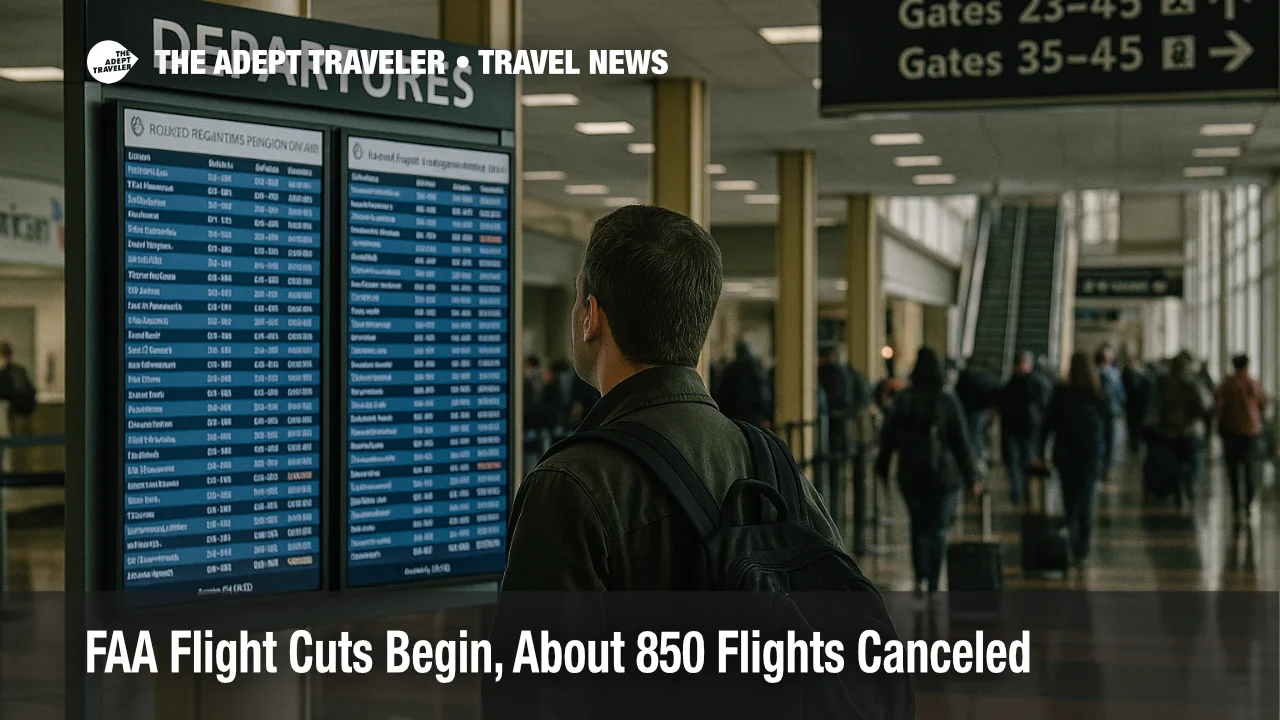FAA Flight Cuts Begin, About 850 Flights Canceled

Key points
- FAA's phased domestic flight reductions at 40 airports start at 4 percent and rise to 10 percent by November 14
- By early afternoon November 7, roughly 850 U.S. flights were canceled and several thousand delayed
- Transportation Secretary Sean Duffy says cuts could reach 15 to 20 percent if the shutdown persists
- United, Delta, and American are offering flexible refunds, including for typically nonrefundable fares
- International long haul is largely excluded while domestic routes take most of the cuts
- Shutdown strain on unpaid air traffic controllers is the FAA's stated safety rationale
Impact
- Rebook Early
- Shift to earlier departures and avoid tight connections during the November 7 to 14 ramp
- Watch Domestic Legs
- Expect higher risk of cancellations on domestic and regional routes while most long haul international is preserved
- Use Waivers
- United, Delta, and American are offering broad refunds or fee-free changes including some basic fares
- Monitor Your Airport
- The 40-airport program targets major hubs, so check day-before status and day-of alerts
- Holiday Cushion
- Build larger buffers for Thanksgiving travel if the shutdown and reductions continue
The Federal Aviation Administration's phased reduction in domestic flights began Friday, November 7, at 40 high-traffic U.S. airports. The plan starts with a 4 percent cut and is scheduled to step up to 6 percent on November 11, 8 percent on November 13, and 10 percent on November 14. By early afternoon Friday, about 850 flights within, into, or out of the United States were canceled and several thousand were delayed. Officials say the moves are designed to manage safety risks tied to unpaid and understaffed air traffic control facilities during the prolonged federal shutdown. International long-haul flying is, in general, not targeted by the order. Travelers should expect rolling adjustments at domestic hubs over the next week.
What changed and where it bites
The FAA's emergency order applies to 40 named airports and surrounding metroplex airspace, with a uniform ramp from today's 4 percent to 10 percent by November 14. Airlines began implementing the first-day cuts overnight, concentrating cancellations on domestic and regional flights while trying to protect long-haul and hub-to-hub services. Multiple outlets confirm that Friday's cancellations numbered in the high hundreds by midday, consistent with the agency's four percent cap, with delays in the low thousands as schedules and crews adjusted.
United and Delta each confirmed initial trims, roughly four percent for United through the weekend and similar magnitudes at Delta, with both carriers signaling that deeper reductions are possible if the shutdown continues. American reported significant passenger impacts as well. Several carriers emphasized that international long-haul flying would be largely preserved during this phase.
Latest developments
Transportation Secretary Sean Duffy said Friday that cuts could reach 15 to 20 percent in a worst-case scenario if staffing further deteriorates and the shutdown persists. For now, the FAA plan caps reductions at 10 percent by November 14. The department reiterated that the priority is to keep the system safe while avoiding uncontrolled day-of disruptions.
Airlines are issuing unusually broad flexibility. United's CEO said any customer traveling during the reduction window can request a refund even if their flight is not directly canceled, including basic economy. Delta and American published similar guidance allowing changes and refunds during the initial period. Check the carrier's waiver page before making changes, and use airline apps for fastest rebooking.
Background
Why is this happening at all. The shutdown has pushed controllers and other aviation safety professionals to work without pay, exacerbating an already tight staffing picture. NATCA, the controllers' union, has warned for weeks about fatigue, morale, and attrition risks, while emphasizing that members remain focused on safety. The FAA says a managed, published reduction is safer than ad-hoc ground stops caused by last-minute staffing holes. If the shutdown drags on, the agency may expand restrictions or extend the timeline into the holiday travel period.
Analysis, traveler choices
Expect a bumpy week of rolling cancellations concentrated on domestic legs, particularly thinner regional feeds. If you are already ticketed, move to earlier flights on the same day, and avoid sub-60-minute domestic connections through the affected hubs. If your trip is discretionary, consider shifting travel outside the November 7 to 14 ramp or take advantage of temporary refund policies. For international journeys, the highest risk sits on the domestic positioning segment, not the long-haul itself, so consider overnighting at the gateway to de-risk. If reductions escalate beyond 10 percent, anticipate wider schedule reshaping and more aggressive day-before pre-cancels to preserve predictability.
Final thoughts
The FAA's controlled cuts are meant to trade frequency for predictability while controller staffing is strained by the shutdown. For the coming week, assume domestic schedules are tighter, long-haul is steadier, and flexible refund policies are unusually generous. Build buffers, rebook early, and watch for updates the evening before departure.
Sources
- Hundreds of US flights cancelled as airport restrictions take effect
- FAA releases details on flight cuts that start at 6 a.m. Friday
- United, Delta begin cancelling flights under FAA directive
- These 40 airports will be impacted by the FAA's capacity cuts and flight cancellations
- Travelers face cancellations and frustration as the FAA orders flight cuts due to the shutdown
- United: An Update on the Government Shutdown
- Delta reduces flights, offers flexibility during FAA directive
- FAA to cut flights at 40 airports if shutdown continues, live updates
- NATCA statement on the ongoing government shutdown
